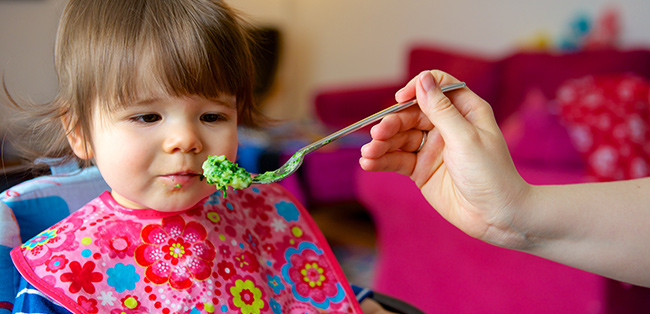But we also know that’s easier said than done, particularly with very young children. There’s plenty you can do to encourage kids to eat balanced, nutritious meals and snacks.
Here are five top tips to keep your little ones on the right nutritional path…
1. Up their iron intake
Iron is important for children’s physical growth and development. It allows oxygen to travel through the body via red blood cells, and helps muscles store and use that oxygen, playing an important part in brain development and learning.
Red meat, turkey, vegetables like kale, broccoli or sprouts, and beans and pulses are all iron-rich. You can also look out for infant cereals that have been fortified with iron, which is a great source of iron for toddlers.
2. Give them a rainbow of veggies
Vegetables come in an almost mind-boggling array of sizes, shapes, colours, and textures – and they all contain vitally important vitamins and minerals.
You can mash or purée peas, sweet potatoes, or carrots for your infant, from when you start weaning. The consistency will be easy for them to swallow, while discovering new tastes they love.
Toddlers and pre-schoolers can try small cubes of soft cooked veggies. Graduate on to finger foods and mild dips like red and green pepper slices with guacamole or hummus once they’re ready.
3. Include plenty of whole grains
Whole grains help with weight management and can reduce the risk of heart disease in the future. They’re a great source of fibre, which digests slowly, helping us feel fuller for longer and promote a healthy digestive system to fend off constipation and diarrhoea.
Whole grains also contain B vitamins like thiamine, riboflavin, niacin, and folates. These help the body to break down the nutrients in food so that complex carbohydrates, fats, and protein can be put to use.
Look for whole grain infant cereals, bread, rice, pasta, crackers and cereal bars for healthy meal and snack time options.
4. Dish up the dairy
Your body needs calcium to produce strong bones and teeth, while the heart and muscles also need it to function properly. And what’s a great source of calcium? That’s right – milk. Once we hit adulthood, the body no longer converts calcium into bone in the same way, so it’s important that children get enough.
Try serving milk at all mealtimes or take a yogurt with you for on-the-go goodness. You could even try adding a slice of cheese to sandwiches – cheese is full of calcium too.
5. Befriend that sweet tooth
It’s common knowledge that kids have a sweet tooth, but you can turn this to your advantage by giving them sweeter-tasting healthy options.
Fruit is a firm favourite, so offer it at meals and snack times. You can mix things up by including fresh, frozen, dried and canned fruit. Add yogurt and some whole grain cereal for an interesting extra texture – children will love the variety.
And if it’s a warm day, why not get those creative juices flowing, with a fruit and yoghurt smoothie for a refreshing treat?
Read more about Nestlé for Healthier Kids, our flagship initiative to help future generations eat better foods and beverages, and to move more. The program aims to help 50 million children lead healthier lives by 2030.
First published as ‘Six Findings from the Nestlé Infants and Toddlers Study’ (pdf, 346Kb) on Nestle USA.











